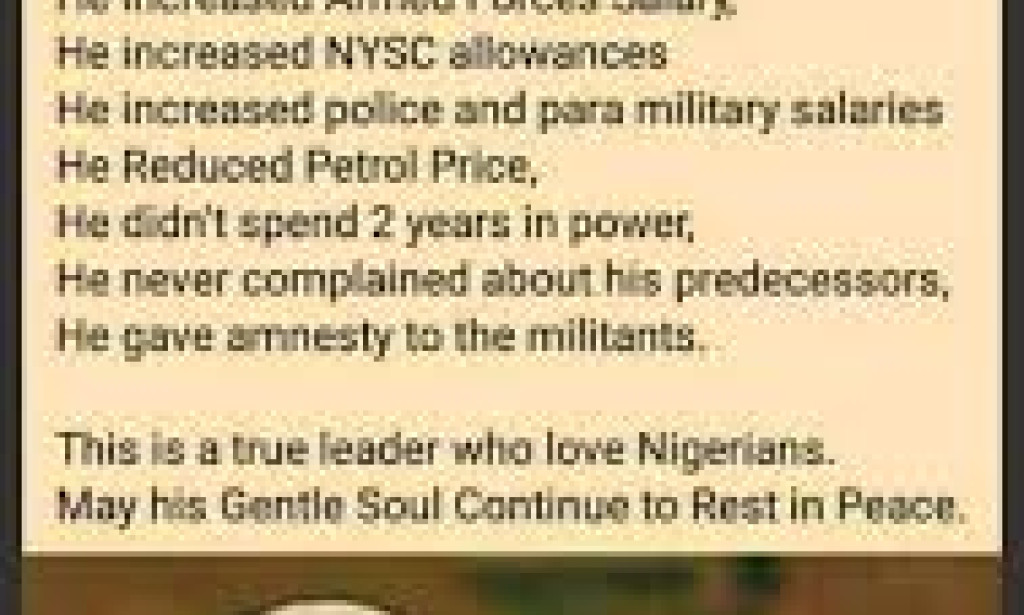This is a ranking of Nigeria’s Top 10 Presidents/Heads of State by poverty reduction — based on job creation, economic inclusion, rural development, food security, and real income gains, rather than just GDP growth.
✓ 1. Umaru Musa Yar’Adua (2007–2010)
Poverty Reduction Efforts:
Launched Niger Delta Amnesty Program – restored oil production and income in the region.
Promoted agriculture and rural development.
Implemented 7-Point Agenda targeting power, education, and food security.
Prioritized rule of law, creating a better environment for small businesses.
Outcome: Short tenure, but impactful in stabilizing income sources, especially in the oil-producing south.
✓ 2. Olusegun Obasanjo (1999–2007)
Poverty Reduction Efforts:
Initiated National Poverty Eradication Programme (NAPEP).
Expanded telecoms — over 50 million jobs created in the ICT sector.
Paid off foreign debt — more funds redirected toward education, healthcare, and roads.
Promoted micro-credit and SME funding.
Outcome: Middle class expanded; urban poverty reduced.
✓ 3. Goodluck Jonathan (2010–2015)
Poverty Reduction Efforts:
YOUWIN and SURE-P programs created jobs for youth and women.
Boosted agriculture through e-wallet fertilizer system (cut middlemen corruption).
Built Almajiri schools to educate vulnerable children in the North.
Outcome: Some rural poverty reduction, though national inequality widened.
✓ 4. Muhammadu Buhari (2015–2023)
Poverty Reduction Efforts:
National Social Investment Programmes: N-Power, TraderMoni, Conditional Cash Transfers.
Focused on agriculture via Anchor Borrowers’ Program.
Massive investments in infrastructure and rural roads.
Challenges: Two recessions, inflation, and high unemployment reversed many gains.
Outcome: Mixed; efforts noted, but over 130 million Nigerians lived in poverty by 2022.
✓ 5. Yakubu Gowon (1966–1975)
Poverty Reduction Efforts:
Used oil wealth to fund education, hospitals, and housing.
National development plans targeted rural areas.
Outcome: Growth not evenly distributed; poverty persisted in the North.
✓ 6. Murtala Mohammed (1975–1976)
Poverty Reduction Efforts:
Focused on government accountability, cutting waste and corruption.
Improved civil service efficiency to support public services.
Outcome: Brief time in office limited results.
✓ 7. Shehu Shagari (1979–1983)
Poverty Reduction Efforts:
Launched Green Revolution to boost food production.
Created thousands of jobs in agriculture and housing.
Challenges: Oil price crash, economic crisis reversed progress.
✓ 8. Ibrahim Babangida (1985–1993)
Poverty Reduction Efforts:
Established People’s Bank and DFRRI to support rural poor.
Founded Better Life for Rural Women (with Maryam Babangida).
Challenges: Structural Adjustment Program led to rising food prices and poverty for many.
Outcome: Poverty significantly increased during his rule.
✓ 9. Ernest Shonekan (1993)
Poverty Reduction Efforts:
Promised reforms to stabilize inflation and boost employment.
Outcome: Not enough time in office (3 months) to effect meaningful change.
✓ 10. Nnamdi Azikiwe (1963–1966) (ceremonial president)
No executive powers over economy or
poverty programs.
Poverty reduction policies came under PM Tafawa Balewa, with modest impact pre-civil war.

You must be logged in to post a comment.